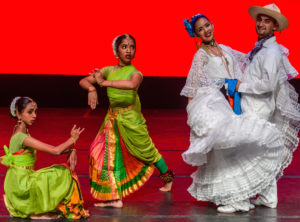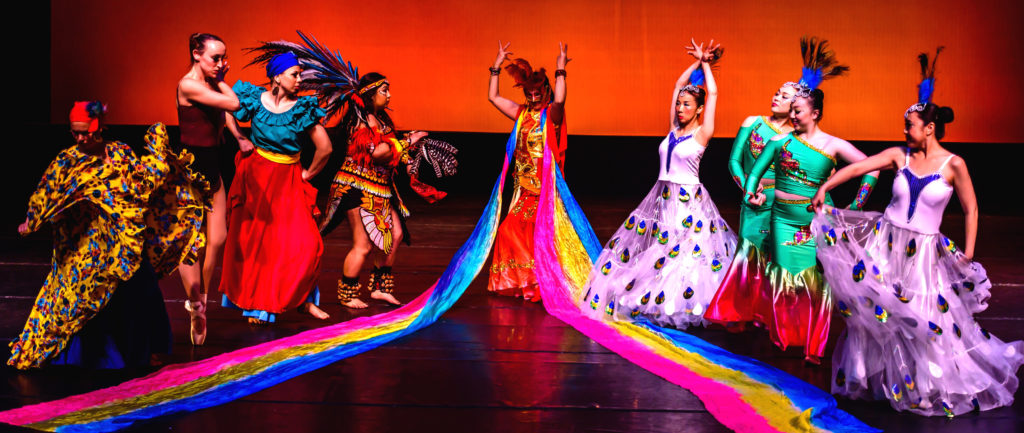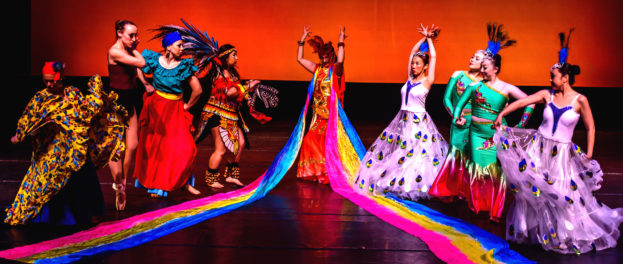
The Conference of the Birds originally was a medieval Persian poem by ‘Attar (“The Pharmacist”)—who influenced the younger, more famous poet and Sufi mystic Rumi—an allegory about the birds of the world debating whether or not to fly away and seek their king, the Simorgh, “thirty birds” in Persian…
800 years later the poem was adapted by a famous French screenwriter and a renowned British stage director as a storytelling play to tour Sub-Saharan Africa during the 1970s, starring an international cast that included Helen Mirren.
Now coming to roost onstage in San Jose is a unique production, featuring 30 dancers from 10 diverse world dance traditions dancing the roles of the birds, with a cast of 15 Bay Area actors playing (and singing) the characters in the parables the birds tell each other—and the audience—during the birds’ debate and their journey that follows, complimented by the sounds of music by multi-instrumentalist Randy Armstrong.
The Conference of the Birds, produced by EnActe Arts and Sangam Arts, will have three performances leading up to the anniversary of 9/11 at the Mexican Heritage Plaza in San Jose. It is, according to Vinita Sud Belani, EnActe’s founder and stage director, “a celebration of the Bay Area we live in today, not just in the ethnic diversity of our actors and dancers, but also in the interpretation – classical [and folk] dance blending in with high-tech projection design by [ filmmaker] David Murakami. This is Silicon Valley, after all!”
A long, meandering journey for the birds and their story. This leg of the journey began years back in Paris, where Belani found herself at a party talking with writer Jean-Claude Carrière. (Carrière has collaborated with filmmakers like Jacques Tati, Luis Bun?uel and San Francisco’s Philip Kaufman, and has been awarded an Oscar.)
“I couldn’t believe I was next to the man [Carrière] who, with Peter Brook, had brought the Mahabharata [India’s great epic poem, source for much South Asian theater and dance] to Western audiences!” Belani recalled. “He said how sad he was that the famous production wasn’t ongoing. We started talking about doing a revival of it – and I left my job and started a theater company! Everything I do is because I met Jean-Claude.”
(Belani may’ve made and left a career in computer science, but art as well as tech were present in her life, growing up. Her father, Dev Sud, is a mechanical engineer; her mother, Aruna Sud, had been a vocalist, tabla player and Kathak dancer before raising a family.)
Carrière came twice to America with a 90-minute storytelling version of Mahabharata, mainly for museums (including San Francisco’s Asian Art Museum in 2013). The tour was a step toward producing the 9 1/2 hour stage version, which is Belani’s dream. While at Phillips Exeter Academy during 2014 with Carrière, Belani met Randy Armstrong, the show’s musician, who had composed the score for an earlier production of Mahabharata at the Academy.
“Randy owns and plays over 300 instruments from around the world,” said Belani, who turned to him for scoring Conference of the Birds.
Discovering Carrière’s script for Conference of the Birds convinced Belani to stage it here. She says, “Like The Mahabharata, its stories taken from cultural and religious context, staged in Brook’s minimalistic style. Not everybody in India was happy with Brook’s lack of sumptuousness for our country’s great epic!”
Sumptuousness for Conference manifested as dancers and elaborate costumes from different traditions, for which Usha Srinivasan of Sangam Arts is greatly responsible. “I saw the San Francisco Ethnic Dance Festival,” Belani said, “And had an ‘Aha!’ moment: These kids, the dance students, go to school together, but don’t dance together – that is, besides dancing in the [respective] ethnic dance form. I met the board at World Arts West, producers of the Festival; they introduced me to Usha.” Srinivasan, coincidentally, had just presented eight different Indian dance styles together for the first time at the Ethnic Dance Festival.
Priya Das, production manager, defined Sangam Arts’ contribution as “curating the dances, matching each bird to an ethos, each emotion naturally reflected by that dance. The production team is mostly Indian.
Usha worked to keep it from being any one community and had the network to bring in dancers from other communities.”
Srinivasan expanded on that note: “The pairing of bird to dance was important, not only for the dramatic element, but also for recognizing the contribution of each form in building the art scene in the Silicon Valley to what it is today.”
Srinivasan, who also left a career in tech to produce performing arts, elaborated on the production’s philosophy: “Until a few years ago, each community was living insulated from other cultures, or they integrated into the ‘melting pot’ where they lost their differences in a unique but homogenous American culture. With the influx of immigrants from diverse social and religious backgrounds, we see the melting pot giving way to a salad bowl, where people retain cultural identity while contributing their own distinct flavors.”
(Srinivasan and Belani jointly finished the statement: “Putting on Conference of the Birds is a way to make a delicious salad dressing!”)
“It was all in Vinita’s head, but came together through serendipity,” as Das said. Serendipity, present since Belani’s chance meeting with Carrière, succeeded in getting the show on its “three legs,” according to Belani. “The overall vision; dancers from different art forms playing the birds; and actors for the rest, who dance and sing, too – and the music … You can’t separate dance, music and theater! … But how to present it? What did we want to say?”
The projection design by Murakami freed the production from sets. “The birds don’t stay in one place, anyway,” commented Belani. “They’re of all nations; they belong to the world. We show images from across the globe. The parables are Persian, with images of Persian palaces, gardens – wherever the action is set.”

Then there was the challenge of what dance forms would represent the various birds, and how to determine that. “We have Folkloric, Aztec, Hula, belly dancers … and the match-up was based on look and feel. Usha had a lot of fun with that,” Belani said.
As Das put it: “Which bird? And which dance company? Who could work collaboratively? And who was booked? … So many moving parts!”
The birds and the dancers and dance companies of various styles who represent them are: Heron: Folkloric [Los Lupeños de San José]; Phoenix and Peacock: Chinese [Hai Yan Chinese Dance Company]; Spar- row: Contemporary Ballet [sjDANCEo]; Moths: Kathak [Antara Bhardwaj]; Parrots: Bharatanatyam [Navia Dance Academy]; Ducks: Hula [Halau Napuaokamokihama cha]; Partridges: Bellydance [Hala Dance]; Walking Birds: Aztec [Yeli Parra]; Simorgh: Persian/Silk Road/Su [Saher Dehghan Dance Company]; Owl: Afro-Brazilian [World Dance Fusion]; Exotic Birds: Odissi [Guru Shradha Dance Company]
Antara Bhardwaj, music and dance director—and performer—choreographed the Kathak pieces she dances as the Moth. There are nine other choreographers she coordinates. “It’s complicated,” she remarked. “40 pieces of music [for the play], from 15 seconds to seven minutes long – and Randy did it singlehanded. It is more like scoring for a play [than for a dance concert] – it’s emotionally driven. And all of the birds, all the dancers, are onstage all of the time reacting to the play’s action.” Bhardwaj summed up: “As an artist, you want constant challenges. We’re stretching the boundaries.”
Stretching boundaries is a good motto for the production. “No borders of gender, age; the cast ranges from nine to 85,” Belani said. “Everybody from everywhere. All-encompassing, all-embracing, overlaying one culture
on the other. Amazing exercise in breaking down boundaries. We have a big budget. And the money’s come! As if it was meant to happen!
“And the birds have come, too! The actors rehearsed outdoors, in my backyard
in Sunnyvale, before moving to a hall with wood floor for dancers. And birds came to sit on the trees and talk to us. Once a heron came; one day a sparrow flew down onto an actor.”
The show’s press release cites the ending of Conference of the Birds: “When the birds finally reach the end of [their arduous] journey, the dwelling place of the Simorgh, all they find is a lake and their own reflection. The question may be asked, is this the end of their journey or the beginning?”
Belani had one response, to what a local poet and translator has called cultural narcissism: “The common person needs to step up and participate in a multicultural dialogue, to integrate their roots in a diverse community. Looking at what’s happening in the world today, the arts are a good way to define and discuss what’s going on. We need to participate. With love and hate, it’s easier to hate than to love.”


